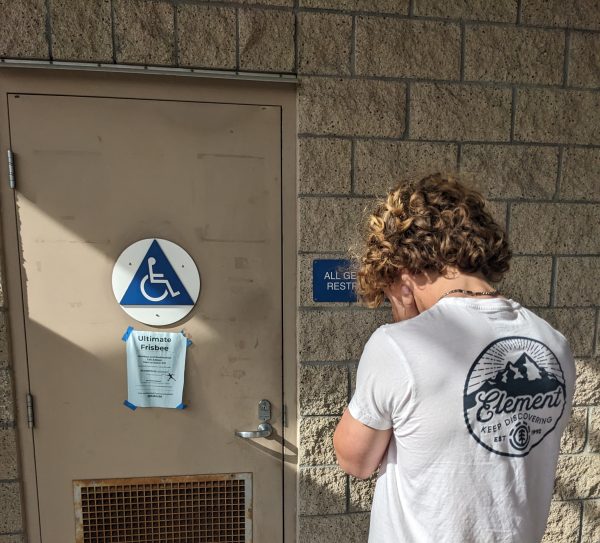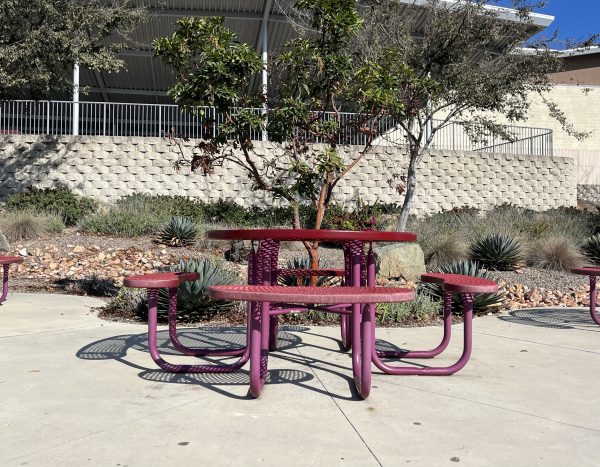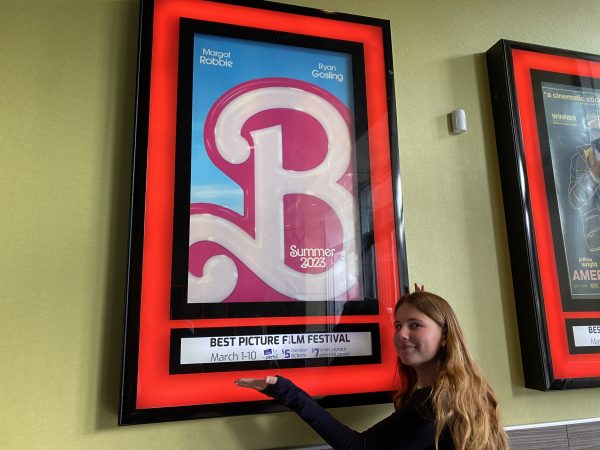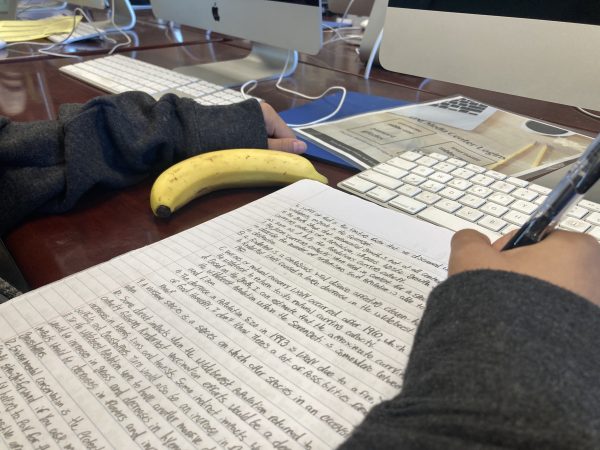Not all Californians are eager to jump on the bullet train bandwagon
The high speed rail line may be a bumpy ride with new problems arising.
Photo by Laura Rico-Zarate
Illustration by Laura Rico-Zarate
January 29, 2019
The never-ending issue of politics and dollar signs is popping up again, and the problem is centered on a high-speed rail designed to run between San Francisco and Los Angeles. While some Californians are singing the praises of the high speed rail line, others focus on the drawbacks of this expensive and landscape-altering project.
“The bullet train is an interesting piece of technology, but, at present, I don’t think California’s funds should be spent on high speed rail,” Richard Tanaka (11) said.
Supporters of the bullet train point to the jobs its construction is bringing to the populous San Joaquin Valley. Over 2,300 workers are employed at 20 different job sites related to the high-speed rail project, which has enhanced economic opportunity in a traditionally low-income region of California. In Fresno County alone, where a substantial portion of the high-speed rail construction is taking place, employment opportunities have increased by 30 percent.
All that glitters is not gold, however, and the idea that the bullet train will speed into the future, leaving jobs in its wake, is not the whole story behind the high-speed rail. Opponents view the bullet train’s construction as a carbon-emitting monster that will add harmful greenhouse gases to the atmosphere. Farmers and environmental groups have been especially vocal in their opposition to the bullet train, whose proposed track will dramatically alter present pumps, irrigation systems and wells.
“I think the concept of a bullet train is exciting, but the drawbacks don’t make it worth it,” Akash Mahajan (10) said.
The ultimate drawback to the project is the Achilles’ heel of many public works endeavors: money. The first phase alone of the bullet train construction has jumped to an astonishing $10.6 billion. The early proposals suggested the total cost of the bullet train, from start to finish, would be $37 billion dollars. As costs skyrocket, it is frightening to consider what the price tag will be when the train and rail is finally complete.
“I work for Carl DeMaio making phone calls, and this is a subject that comes up frequently. From what I’ve learned from my experience there, I think government money could be used in a better way,” Tanaka said.
Although there are many potential problems to consider when examining the idea of a bullet train, this new technology is ultimately another step in the search for new modes of transportation. While the proposals aren’t flawless, they are rudimentary attempts to engineer a better tomorrow; even if the bullet train is on a collision course with a staggering amount of debt, at least the riders will be seated comfortably as they hurtle towards financial ruin.
















Hannah Larson • Feb 11, 2019 at 1:52 pm
Hi Olivia! Thank you so much for reading about the bullet train! I think it’s interesting to consider many sides of this current issue. Thanks again for taking a look at the Silvertip!
Olivia Miller • Feb 8, 2019 at 3:12 pm
Great article as always, Hannah! I love your description and your wordchoice is excellent! I especially enjoyed your “All that glitters is not gold…” statement, as well as the last paragraph! Keep up the great work!
Hannah Larson • Feb 8, 2019 at 1:08 pm
Hi Abby! Thanks so much for reading about the impact California’s proposed bullet train will have on our state. There are definitely a lot of drawbacks to consider.
Hannah Larson • Feb 6, 2019 at 7:07 pm
Hi Quincy! Thanks so much for reading about the bullet train and the problems and opportunities that are coming with it. I like your idea about using the $37 billion dollars to construct homes and schools in areas where they may be needed. Although the train is an exciting idea, there are many issues that come along with it. Thanks for reading the article!
Hannah Larson • Feb 6, 2019 at 7:03 pm
Hi Joanna! Thanks so much for reading about the bullet train and the impact it is having on California. I definitely agree with you that there are financial drawbacks to the project, and a lot of debt is building up as construction continues. There are environmental concerns as well, and it makes us take a critical look at the impact of the train. Thanks again for reading the article!
Hannah Larson • Feb 6, 2019 at 6:58 pm
Hi Donovan! Thanks so much for reading this article about the impact the bullet train is having on California. Most of the jobs that the bullet train is bringing are related to construction. Groups of construction workers are designing and building structures at multiple sites. Some rail car components are being bought from U.S. factories, which is an additional source of jobs. In addition, cities are building up around the proposed tracks due to the business the train will bring. Thanks again for reading about the bullet train!
Hannah Larson • Feb 6, 2019 at 6:51 pm
Hi Caleb! Thanks so much for reading about the bullet train. If the project works out, it will have the potential to reduce the amount of vehicles travelling on the road, which in turn will lead to less traffic congestion. As to if it will travel along the length of California, the approved proposal was specifically focused on a route from Los Angeles to San Francisco rather than connecting the northernmost and southernmost points of the state. So it appears that the route won’t be from top to bottom, but perhaps in the future the two ends will be connected by rail. Thanks again for reading!
Hannah Larson • Feb 6, 2019 at 6:45 pm
Hi Devon! There is a huge price tag attached to the construction of the bullet train, which is definitely a concern. There are high speed trains in other countries that run on electricity, so that is a power option that needs to be explored. Perhaps if a more sustainable energy source was discovered, the cost would go down and the bio-efficiency of the train would go up. Thanks for your comment and for reading the article!
Abby Larson • Feb 6, 2019 at 5:46 pm
Wow Hannah! Great article! I especially like your literary allusion to Achilles’ Heel. Also, wonderful ending. I really enjoyed reading it!
Hannah Larson • Feb 6, 2019 at 2:46 pm
Hi Andrea! Debt is a huge issue to consider when looking at the pros and cons of the bullet train. The billions of dollars that are being put towards the train are seen by some as concerning because the high speed rail has not yet begun to pay back the money that has been put into it. Thanks so much for reading!
Hannah Larson • Feb 6, 2019 at 2:41 pm
Hi Nebojsa! That’s a great point you have about how funds could be spent on issues other than the bullet train. There are so many projects that money could go towards instead of being devoted to the train. Thanks for reading!
Hannah Larson • Feb 6, 2019 at 2:39 pm
Thanks for reading, Christian! I’m glad you liked the article. The train is very expensive and the cost keeps going up. We definitely need to take California’s financial situation into consideration.
Hannah Larson • Feb 6, 2019 at 2:36 pm
Hi Enrique! High speed rail tracks have different standards than traditional tracks used for railroads. Bullet train tracks are designed with less friction than tracks used for freight trains in order to increase their speed. High-speed rail tracks may be magnetic or electric, depending on the design. As to the technology, the California High Speed Rail Authority is committed to constructing the rail with recycled concrete and steel. There are proposals to have the train get its electric power from overhead wires on the power grid. When the train brakes, it would recycle the energy back to the grid, which would save power and lower costs. Thanks so much for reading!
Hannah Larson • Feb 6, 2019 at 2:20 pm
Hi Fayez! The rail line is being completed in segments, and passenger service between San Jose and Bakersfield is projected to be completed in 2025. The second leg of the project is expected to open in 2029, and the rest of the track should be in operation by 2040. There’s still quite a bit of construction left! In regards to the price, a study by the Los Angeles Times suggests that it would cost a passenger $86 per ride, but that number will most likely climb the longer it takes to finish construction. The train will also have an impact on the climate. Because over two thirds of the world’s electricity comes from fossil fuels, electric trains have the potential to negatively affect the environment. Thanks for reading!
Hannah Larson • Feb 6, 2019 at 2:00 pm
Hi Delfino! I definitely support the bullet train , but think that the cost could have been handled better from the beginning. If funds are used appropriately from here on out, the bullet train will be an exciting new addition to California.
Hannah Larson • Feb 6, 2019 at 1:52 pm
Hi Cesar! There is definitely a huge price tag attached to the bullet train; it’s something to consider for sure. Thanks for reading!
Hannah Larson • Feb 6, 2019 at 1:47 pm
Hi Mrs. Horrigan! That’s a great point about a bullet train drawing tourists to California. The money put into the rail system could be regained by charging riders a reasonable fee. It would be incredible if the bullet train can become a reality .
Hannah Larson • Feb 6, 2019 at 1:37 pm
Hi Quincy! I definitely agree that a bullet train is a poor way to spend funds.
Mrs. Horrigan • Feb 5, 2019 at 11:18 am
Great article choice, Hannah! I’ve traveled the rail system throughout Europe and Japan and I love the idea of making California more train-friendly. The more people who take public transportation, the less cars are on the road which is a benefit to our environment. Trains are typically more affordable than planes; I would be more likely to travel with my family of five up the coast of CA if there were a bullet train. The train could bring more tourism to CA which could lead to more tax dollars back into the economy.
Cesar • Feb 4, 2019 at 11:51 am
I appreciate how the author gave examples of why the train is something they should build and why they shouldn’t . What stood out to me is that the total cost of the train will be 37 billion dollars. In my opinion they shouldn’t build this train because its too expensive.
Delfino • Feb 4, 2019 at 11:50 am
I like this article. I appreciate how the writer is caring about where the money goes. Is she okay with people making the bullet train??
Fayez Eyabi • Feb 4, 2019 at 11:50 am
I found it very interesting how the budget of this bullet train is so high in price. And as well as it’s price but how long would something of this length take to be constructed? Then would it be reasonably priced for the average American spend on the train fare? Ultimately would it be worth constructing due to it’s enormous release of carbon into the environment, which would increase our green house gases as a state?
Enrique Guzman • Feb 4, 2019 at 11:49 am
I like how she included reasonable quotes about how California shouldn’t waste their money on some fast moving train. I also like the fact she has put in the cost of building the bullet train if that’s what we’re naming it. What stood out to me the most would be the way she brought in the damage the train can bring to our world, with green house effect already slowly harming the environment. What type of railings would be used? What type of technology would be useful to have faster moving train? In my opinion, I wouldn’t want a faster train than what we have already. The casualties can be bad as well.
Christian Lopez • Feb 4, 2019 at 11:47 am
What stood out to me was that there was a bullet train bandwagon. I liked it, because it was very interesting and how they showed the effects in the world and how they could be fixed in California. It is also interesting because the train would be 37 billion dollars.
Nebojsa Gavrilovic • Feb 4, 2019 at 11:47 am
Some of the things that stood out to me was when students spoke about what they think is good and bad about the bullet train bandwagon. I liked that the they showed the affects in the world and how they could be fixed in California. I think that the amount of money spent on the train could be used more on the important items in the world besides transportation.
Andrea Lozano • Feb 4, 2019 at 11:46 am
In my opinion, I agree that creating a bullet train is not worth all the money and labor. Although the project may be giving jobs to many people in the area, the country will be better off in the long run when they don’t have to deal with the debt they will be in. One thing that stood out to me in this article was the conclusion sentence because it gives the reader a better understanding about what they will be getting themselves into if they decide to go along with the bullet train project.
Devon Toner • Feb 4, 2019 at 11:46 am
If they say that this bullet train is gonna be carbon emitting monster why don’t they just make is electric? I also agree with your opinion it is not worth the 37 billion dollars to build this train. But over all great article really enjoyed reading it.
Caleb peterson • Feb 4, 2019 at 11:45 am
I loved this well writen article on how not all Californianians are eager to jump on the bullet train bandwagon. What intrested me was how much the train was gonna cost and how it would effect the life around the train. I want to know if it works out, how would it help people and transportation, and will it go down the whole coast? I liked this article, very well written.
Donovan Jackson • Feb 4, 2019 at 11:45 am
I like that you used factual evidence when you mentioned things like the cost of train. An interesting thing to me is that the train will cost about 37 billion dollars. Why does the train open up so many more jobs for people? In my opinion they should build the train even if it does cost a large amount of money because it is offering more people jobs.
Joanna • Feb 4, 2019 at 11:42 am
I think that the bullet train is not a very good idea. The reason for this is, because of the cost of the fuel that will have to be bought and the cost of build the actual machine. The train will emit a great amount of greenhouse gases that will accelerate the process of global warming. I like that you have written an article about this topic, because it can make us aware of what we are doing to our planet. What stood out to me the most was the cost of building this bullet train, it shows us that we can use this money for something more useful that will help our planet.
quincy scott • Feb 4, 2019 at 11:42 am
The bullet train isn’t really that good of an idea. I mean yeah is goes fast and gets people to places in a good time, but I totally agree with the writer spending 37 billion on a train and rail isn’t a good way to spend that money. We can build more jobs, schools, and houses for the people that need it. Something that stood out to me the most was how much the train and railing was going to cost. My opinion on this topic is, making this train is not the best thing for us people right now.